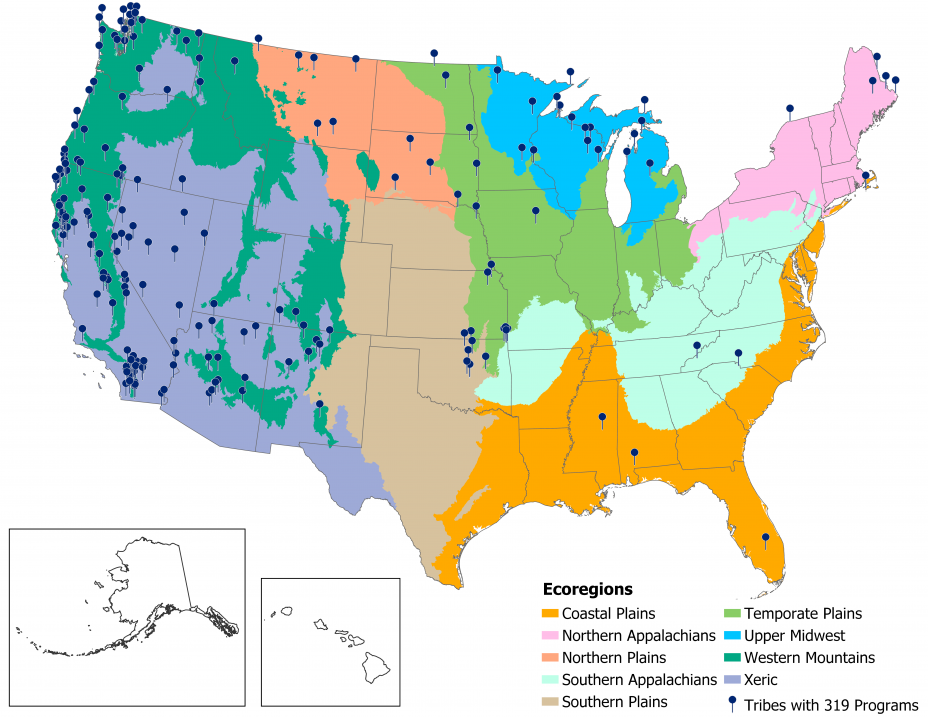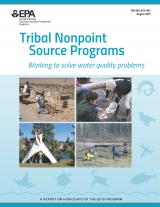Tribal Nonpoint Source Program
New Highlights Report!
This new report illustrates the diverse work and accomplishments of tribal NPS programs supported by §319, including spotlights of projects and staff contributing to tribal NPS successes (published August 2019).
On this page:
Overview
Federally recognized tribal lands cover over 110,000 square miles of the United States. Unlike a single state these lands are held by more than 570 distinct Indian tribes, each with a unique set of water resources used for recreation, transportation, fishing, aquaculture, drinking water, ceremonial purposes, and more. Each tribe faces a unique set of challenges in protecting these resources. Together, Indian tribes are responsible for protecting and restoring tens of thousands of square miles of rivers, streams, and lakes, as well as ground water. Tribes across the country are using Clean Water Act Section 319 grants to assess and manage nonpoint source (NPS) pollution.
Nonpoint source (NPS) pollution, unlike pollution from industrial and sewage treatment plants, comes from many diffuse sources. NPS pollution is caused by rainfall or snowmelt moving over and through the ground. As the runoff moves, it picks up and carries away natural and human-made pollutants, finally depositing them into lakes, rivers, wetlands, coastal waters and ground waters. For more information on types and categories of nonpoint source polution go to the Learn section to the Types of Nonpoint Source water pollution.
Under CWA §319, EPA provides grants and technical assistance to support tribal environmental programs in assessing and managing NPS pollution problems and threats. A wide range of activities are eligible for funding under §319, including but not limited to: NPS training for tribal staff, developing watershed-based plans, riparian planting, livestock exclusion fencing, lake protection and restoration activities, NPS ordinance development, outreach and education, and many more.
Tribal Eligibity Under CWA Section 319
Tribes and intertribal consortia must meet the following four conditions to be eligible to apply for CWA section 319 funding:
- Be federally recognized by the Secretary of the Interior
- Have an approved NPS assessment report in accordance with CWA section 319(a)
- Have an approved NPS management program in accordance with CWA section 319(b)
- Be approved for treatment in a similar manner as a state (TAS) in accordance with CWA section 518(e)
Of the 573 federally recognized tribes, approximately 330 meet the requirements above to apply for TAS. As of federal fiscal year 2021, a total of 209 tribes and intertribal consortia are eligible to apply for §319 grants. Tribes interested in developing NPS pollution management programs using Section 319 funds should contact their EPA regional office for information on how to apply for TAS. More information about the Tribal NPS Program can be found in EPA's Handbook for Developing and Managing Tribal Nonpoint Source Pollution Program (PDF) (182 pp, 8.6MB).
 In federal fiscal year 2019, 203 tribes had EPA-approved NPS programs. Each point represents the center of each tribe's land area. Tribal NPS programs are located within various ecoregions (areas of similar environmental characteristics such as climate, vegetation, and geology), represented in this map using aggregations of EPA Level III ecoregions delineated for EPA's National Aquatic Resource Surveys.
In federal fiscal year 2019, 203 tribes had EPA-approved NPS programs. Each point represents the center of each tribe's land area. Tribal NPS programs are located within various ecoregions (areas of similar environmental characteristics such as climate, vegetation, and geology), represented in this map using aggregations of EPA Level III ecoregions delineated for EPA's National Aquatic Resource Surveys.
EPA Tribal NPS Contacts
- EPA Region 1 -- Boston (serving CT, ME, MA, NH, RI, and VT)
Bessie Wright (wright.elizabeth@epa.gov)
(617) 918-1679 - EPA Region 2 -- New York City (serving NJ, NY, Puerto Rico, and the U.S. Virgin Islands)
Aimee Boucher (boucher.aimee@epa.gov)
(212) 637-3837 - EPA Region 3 -- Philadelphia (serving DE, DC, MD, PA, VA, and WV)
Fred Suffian (suffian.fred@epa.gov)
(215) 814-5753 - EPA Region 4 -- Atlanta (serving AL, FL, GA, KY, MS, NC, SC, and TN)
Sharon Brown (brown.sharon@epa.gov)
(404) 562-9269 - EPA Region 5 -- Chicago (serving IL, IN, MI, MN, OH, and WI)
Janette Marsh (marsh.janette@epa.gov)
(312) 886-4856
- EPA Region 6 -- Dallas (serving AR, LA, NM, OK, and TX)
Nikole Witt (witt.nikole@epa.gov)
(214) 665-2781 - EPA Region 7 -- Kansas City (serving IA, KS, MO, and NE)
Kimberly Hill (hill.kimberly@epa.gov)
(913) 551-7841 - EPA Region 8 -- Denver (serving CO, MT, ND, SD, UT, and WY)
Peter Monahan (monahan.peter@epa.gov)
(303) 312-6946 - EPA Region 9 -- San Francisco (serving AZ, CA, HI, NV, American Samoa, Commonwealth of the Northern Mariana Islands, Federated States of Micronesia, Guam, Marshall Islands, and Republic of Palau)
Howard Kahan (kahan.howard@epa.gov)
(415) 972-3143 - EPA Region 10 -- Seattle (serving AK, ID, OR, and WA)
Krista Mendelman (mendelman.krista@epa.gov)
(206) 553-1571
- EPA Headquarters -- Washington, DC
Steve Epting (epting.steve@epa.gov)
(202) 566-1074

